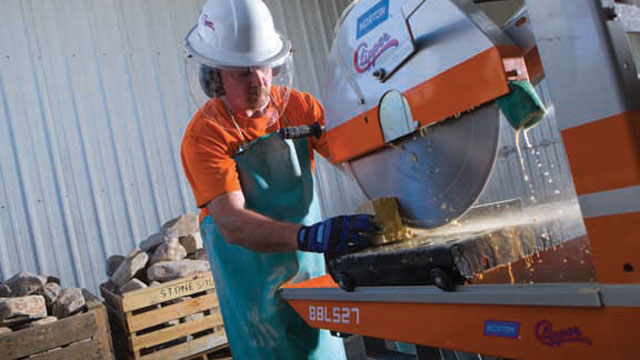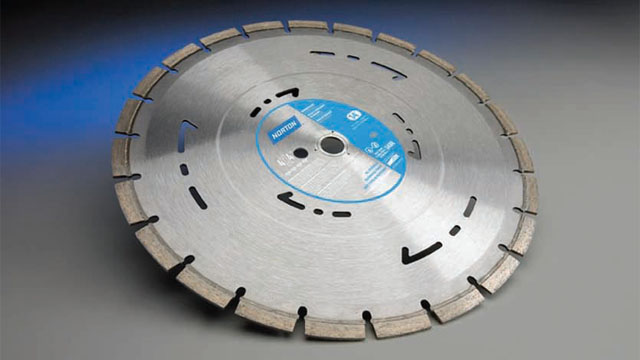June 22, 2011 7:00 AM CDT
As a representative of Norton, a large diamond blade manufacturer, I can tell you that nothing is harder to hear from a contractor than, “a diamond blade is a diamond blade.”
Who knows how this started, but it is furthest from the truth. The general application of diamond blades to masonry materials remains constant, in spite of the many changes to materials, equipment and operators. But the design and technical make-up of blades have evolved significantly.
There are five significant but simple questions:
To keep it simple, we tier by good, better and best. Good, low-cost economy blades, like our Norton Classic line, have a place for quick, easy jobs in which life, production and precision are of no concern. These types of blades may be less expensive, but using them for every application can end up costing a contractor more in the long run.

Then, there is the best innovation tier of blades like our DUO family, 4x4 and Silencio. Blades of this level commonly host patented features to increase productivity and blade life, while furnishing precision in the work. Depending on the blade type, it can be more of an upfront investment, but bring cost down over the blade life. Your work is your livelihood. The blade is an extension of your work. You should always consider how you promote your business.
Blades have come a long way over time from pressing to brazing. More than 25 years ago, Norton introduced the first laser welded diamond blade. The demands of applications continue to force changes in bonds, diamond type and blade cores. Sound dampening is an example of the technology moving the diamond tool industry forward. With laser cut cores to distort the vibrations that cause noise, to epoxy filled sandwich cores, both contribute to softening noise levels.
The request for quieter cutting blades has directed our manufacturing side to seek alternatives to the commonly used methods. Two years ago, Norton introduced the patent pending Silencio diamond blade with two offset cores filled with gel that provided the base to reducing cutting noise by as much as 15 db(A). This is just one solution but it leads to others, like in equipment.
The desire to reduce the sound pollution resulting from diamond blades on masonry equipment is now outpacing the masonry equipment. We are seeing a rising trend today, with the use of high-speed saws and diamond blades to cut masonry materials. Although this is an efficient solution, this approach sacrifices any benefits gained from diamond blade design technology. The need to reduce saw weight and increase the portability of equipment now requires diamond blades to function with less horsepower. In the practical application of the ideal diamond blade, the maximum cutting efficiency is still the result of appropriate match of diamond and bond to the material cut.
So, you see diamond blades are not “just diamond blades.” No doubt they can look very similar in basic design, but much education is needed with regard to material make up, application and type of machine being used.
Diamond Blade Education
Educating a new generation

Norton 4X4 Blade
Remember the old game, in which you start with a statement and pass it along through several people at a whisper and, at the end, find that the statement changed? In some cases, the statement changed so drastically that you wondered how it got so lost in translation. How we educate the younger generation in the masonry business about diamond blades is similar, but we hope the message stays accurate. Being consistent with our procedures and products are some of the most important pieces of information we can pass along to apprentices. This assures the perfection of the craft stays in tact.As a representative of Norton, a large diamond blade manufacturer, I can tell you that nothing is harder to hear from a contractor than, “a diamond blade is a diamond blade.”
Who knows how this started, but it is furthest from the truth. The general application of diamond blades to masonry materials remains constant, in spite of the many changes to materials, equipment and operators. But the design and technical make-up of blades have evolved significantly.
There are five significant but simple questions:
- How deep is the cut?
- What are you cutting?
- Is the application wet or dry?
- How much horsepower for the saw is needed?
- How big is the job?
To keep it simple, we tier by good, better and best. Good, low-cost economy blades, like our Norton Classic line, have a place for quick, easy jobs in which life, production and precision are of no concern. These types of blades may be less expensive, but using them for every application can end up costing a contractor more in the long run.

Norton diamond blade at work.
Mid-grade premium blades, such as the Norton Charger series, bring the operator closer to the application than the fore-mentioned counterpart as the better tier. These blades typically provide improved performance and extended life for medium to large intermittent jobs.Then, there is the best innovation tier of blades like our DUO family, 4x4 and Silencio. Blades of this level commonly host patented features to increase productivity and blade life, while furnishing precision in the work. Depending on the blade type, it can be more of an upfront investment, but bring cost down over the blade life. Your work is your livelihood. The blade is an extension of your work. You should always consider how you promote your business.
Blades have come a long way over time from pressing to brazing. More than 25 years ago, Norton introduced the first laser welded diamond blade. The demands of applications continue to force changes in bonds, diamond type and blade cores. Sound dampening is an example of the technology moving the diamond tool industry forward. With laser cut cores to distort the vibrations that cause noise, to epoxy filled sandwich cores, both contribute to softening noise levels.
The request for quieter cutting blades has directed our manufacturing side to seek alternatives to the commonly used methods. Two years ago, Norton introduced the patent pending Silencio diamond blade with two offset cores filled with gel that provided the base to reducing cutting noise by as much as 15 db(A). This is just one solution but it leads to others, like in equipment.
The desire to reduce the sound pollution resulting from diamond blades on masonry equipment is now outpacing the masonry equipment. We are seeing a rising trend today, with the use of high-speed saws and diamond blades to cut masonry materials. Although this is an efficient solution, this approach sacrifices any benefits gained from diamond blade design technology. The need to reduce saw weight and increase the portability of equipment now requires diamond blades to function with less horsepower. In the practical application of the ideal diamond blade, the maximum cutting efficiency is still the result of appropriate match of diamond and bond to the material cut.
So, you see diamond blades are not “just diamond blades.” No doubt they can look very similar in basic design, but much education is needed with regard to material make up, application and type of machine being used.
Originally published in Masonry magazine.
About the Author
Mark Pendergrass is marketing manager for Norton, a brand of Saint-Gobain Abrasives. He can be contacted at mark.s.pendergrass@saint-gobain.com.


















